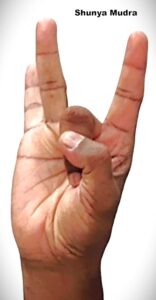Shunya Mudra
Introduction
Mudras are symbolic hand gestures in yoga that influence prana (life energy), promoting physical, mental, and spiritual well-being. Shunya Mudra, also known as the “sky mudra” or “emptiness mudra”, is a mudra that helps alleviate ear-related problems, reduce feelings of emptiness, and enhance mental clarity.
The term “Shunya” in Sanskrit means “sky, emptiness, or void”, symbolizing spiritual expansion, mental clarity, and inner space. This mudra is often used in yogic therapy, meditation, and pranayama practices.
Meaning
Shunya = Sky, emptiness, void.
Mudra = Yogic seal or gesture.
Purpose: To relieve ear-related disorders, reduce dizziness, balance Vata dosha, and enhance focus and mental clarity.
How to Perform (Practice)
Sit comfortably in Sukhasana, Padmasana, or Vajrasana, keeping the spine erect.
Relax shoulders and arms.
Form the mudra:
Bend the middle finger and press its first joint with the thumb.
Keep the other fingers extended.
Rest hands on the thighs or knees, palms facing upward.
Close your eyes and focus on inner stillness, balance, and clarity.
Maintain the mudra for 10–15 minutes, once or twice daily.
Tip: Practice gently without strain; maintain relaxed breathing.
Benefits
Physical Benefits
Helps alleviate ear problems, tinnitus, and hearing issues.
Reduces dizziness and vertigo.
Balances Vata dosha, reducing nervous system imbalances.
Improves circulation in hands and fingers.
Mental & Emotional Benefits
Enhances focus, mental clarity, and alertness.
Reduces mental fatigue and restlessness.
Promotes calmness and emotional stability.
Spiritual Benefits
Expands inner awareness and consciousness.
Supports meditation and mindfulness practices.
Encourages detachment, mental spaciousness, and clarity.
Contraindications
Finger or thumb injuries.
Avoid over-practice if hands or fingers feel strained.
Caution in severe ear infections or vertigo; consult a healthcare provider.
Anatomy & Physiology
Musculoskeletal: Engages intrinsic hand muscles and stabilizes the middle finger.
Circulatory system: Improves blood flow to fingers and hands.
Nervous system: Stimulates sensory nerves and promotes mental calmness.
Auditory system: Indirectly influences ear function and balance through Vata regulation.
Kinesiology
Middle finger bent and pressed by thumb, other fingers extended.
Hands resting on thighs or knees, palms upward.
Shoulders relaxed, wrists neutral.
Enhances finger proprioception, subtle energy flow, and Vata balance.
Neurology
Stimulates peripheral nerves in the fingers and hand, enhancing focus, alertness, and sensory perception.
Balances autonomic nervous system, reducing vertigo and dizziness.
Supports cortical areas related to concentration, mental clarity, and balance.
Facilitates pranic flow and inner stability during meditation.
Duration of Mudra
Beginners: 5–10 minutes.
Intermediate: 10–15 minutes.
Advanced: 15–30 minutes during meditation or pranayama.
Tip: Practice once or twice daily for best results.
Counter Mudra
Prana Mudra: To energize after practice.
Gyan Mudra: To enhance concentration and learning.
Apana Mudra: To release excess energy or tension post-practice.
Conclusion
Shunya Mudra is a therapeutic mudra that relieves ear problems, dizziness, and Vata imbalance while enhancing focus, mental clarity, and spiritual awareness. Regular practice integrates physical, mental, and energetic benefits, making it ideal for meditation, pranayama, and yogic therapy.
FAQ
Q1. Can beginners practice Shunya Mudra?
Yes, it is simple and safe for all levels.
Q2. Can it help with ear problems or vertigo?
Yes, it is especially beneficial for tinnitus, ear fullness, and dizziness.
Q3. How long should it be practiced daily?
10–15 minutes once or twice daily.
Q4. Can it be combined with meditation or pranayama?
Yes, it enhances mindfulness, inner calm, and pranic balance.
References
Swami Satyananda Saraswati, Asana, Pranayama, Mudra, Bandha.
B.K.S. Iyengar, Light on Yoga.
Hatha Yoga Pradipika – Mudras for Vata balance and ear-related issues.
Gheranda Samhita – Mudras for mental clarity and pranic flow.
Kuvalayananda, Yoga Mimamsa Journal.

